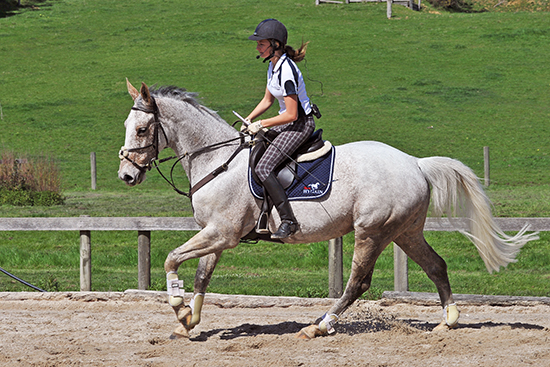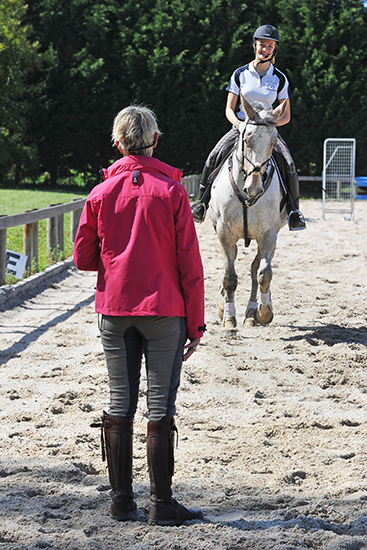 Story by Chris Hector and photos by Roz Neave
Story by Chris Hector and photos by Roz Neave
Seventeen-year-old Jess Hurley is one of the amazing group of exciting young riders who Michelle Strapp currently has under her wing – and like many of Michelle’s riders, Jess is in the situation of having to ‘make her own’: horse that is.
“All my kids have really supportive parents,” says Michelle, “but many of them are not in the position of taking the expensive trip to Europe and bringing home the school master. My students are having to learn how to bring the best out of their uneducated horses, with good basic consistent training, an understanding of how a horse’s body and mind works. One of the side benefits of that, is that there are breeders now, who are breeding well-bred, talented horses in Australia, and they are coming to me and saying, ‘I’d like one of your riders to train and compete one of the horses I’ve bred’. Breeders are very passionate about what they produce, and want their horses to have the best opportunity to reach their maximum level. Young riders need to learn how to be good competitive riders in the ring, but if they are going to be able to stay in the sport without large funds, they will have to learn how to produce horses from the start.”
“It’s interesting, I was talking about it with Gilbert Böckmann a few years ago, and he was saying that while his generation, the generation of Ludger (Beerbaum), Franke (Sloothak), Marcus (Beerbaum), grew up training young horses up to certain levels themselves before they competed them, many of the next generation of riders, are in a financial situation where they can buy experienced horses, and they do become super ring riders. It is great that we are getting young riders up to the top quicker, but Gilbert thinks that they have to be careful they do not lose a generation of trainers, learning the hard miles of training young horses.”
And Michelle is well aware that many of the breeder/rider sweetheart deals have ended up anything but sweet, when the breeder decides to take the horse back the minute it starts to look good. “That’s the first thing I say to the breeders, if you want one of my riders then we’ve got to have a proper contract to protect them.”
Jess is not riding one of the youngsters, her Blackall Park Charity, is a 12-year-old mare, by Trak out of a Daley K mare, but even though she is 12, she is still well and truly a work in progress. The mare was broken in as a six-year-old after having a couple of foals and while she had competed in enough D grade classes to develop a big left drift, she had never confronted the niceties of flatwork.
“She was a bit all over the place when we got her,” Jess tells me. “But she will take off from any spot to any fence, she is really brave and she can jump.”
As usual, Michelle starts by discussing how her pupil went at her most recent competition, Jess is a bit disappointed: “She got hot and running in the ring. She was great in the warm-up, maybe I relaxed too much. I over-added and had a rail, I think I was holding her back…”
Michelle agrees: “That’s the problem with these big horses, it is easy for them to get flat and running, and that type of canter is hard to work with, and does not produce good distances. Then your reaction is to keep her too short in the canter, and end up with backward distances. We need to produce a canter that is forward, but not flat and running. When I ask you to go forward, do not let the rhythm get fast,when you go to put your leg on or she just runs.”
“You need a metronome in your head, listen and feel the rhythm you want to travel at. Her half halts still do not exist. She felt OK in the practice arena, because her blood was not up, and she would have been behind your leg. When you start jumping bigger fences, she gets her blood up, and you get your blood up and when you go to put your leg on when she is spooky, she just runs. She needs to become more responsive to your leg and your half halts.”
And Michelle’s starting point in tackling the problem looks a whole lot like Miguel Tavora’s turn on the forehand – “make sure you are keeping the same beat of the walk, and keep your eyes up to ride a line out of the exercise. That is the secret, your line and your speed. You might read about how to do a half-halt in a book, but there are really 1000 levels of half-halts, and which one you use depends on what you need. If you do not decide what line and pace you want to travel, how can you decide what level of aid to use?”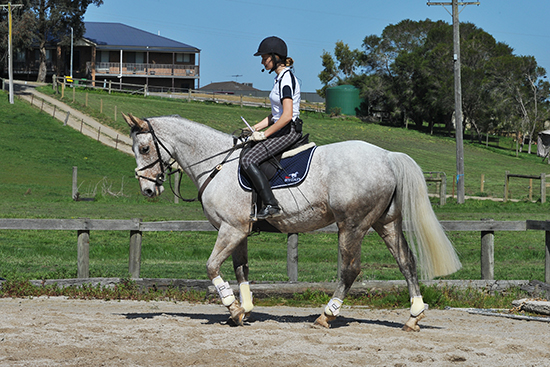
“Now trot on, let’s see how straight she is today. Take the twist out of her neck, she likes to travel like a banana to the right, – instead of riding a circle, ride a diamond, ride forward and straight, you need to get her shoulders straight – it’s like riding the centre of a combination. See, she wiggles like a snake, you must get her straight. This sort of horse is lovely, she has such scope, but you need to sit tall on her and use your legs, don’t just sit on top of her or you are going to keep riding her off your hand, and she will stay strog and heavy. You cannot muscle her with your arms to get her straight, she must respond to your legs.”
“Ignore it when she tosses her head, just keep your hands still, but not with a locked arm, and concentrate on your line, your rhythm – and the head toss will solve itself. If I get you focused on the toss, you will only start focusing on the front, I need to get you to start taking control of the horse’s body.”
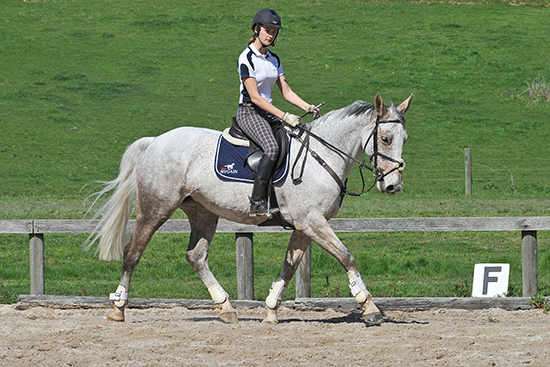
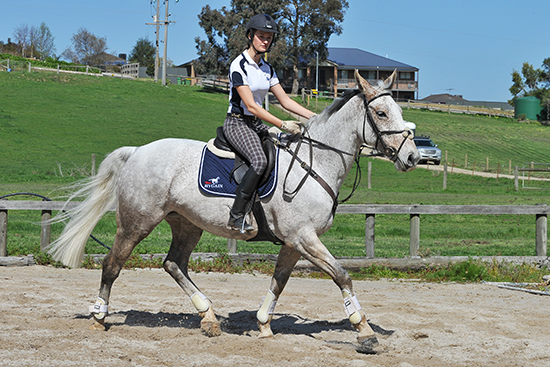 “Transition to walk … see, as she goes to walk she starts to separate. It is the same when you are approaching a fence, she gets into that runny flat canter and separates, then you start to add.”
“Transition to walk … see, as she goes to walk she starts to separate. It is the same when you are approaching a fence, she gets into that runny flat canter and separates, then you start to add.”
“When you ask for the transition down to walk, and she sticks her neck out and flattens, activate her back to trot and engage again from the hind quarters, don’t just pull the front in. The thing is, when you start to feel uncomfortable, the natural instinct is to grab. NO – you have to make it so that your natural instinct when things go wrong is leg to hand. I am not suggesting you go around with no contact, but as she resists keep your hands still and activate the hind leg back up to your hand, and then soften your contact, and if she runs as you give, repeat the exercise. She has to learn to carry her self; your hands cannot be her fifth leg.”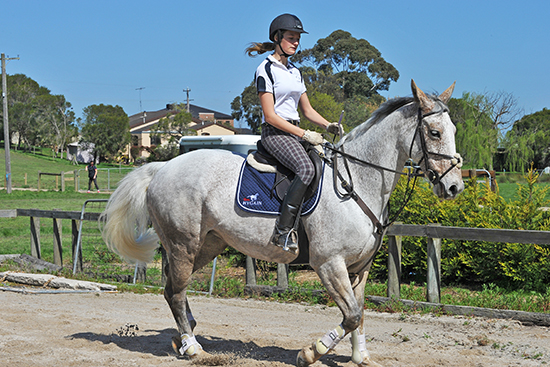
“Another walk transition, keep your hands still. Feel that, she started to soften into the transitions? She needs 1000s of those because she doesn’t understand the half-halt, all she understands is stop and go, and the half-halt is crucial for your jumping because the course builder is always asking you to adjust your canter.”
“Now canter on, and in the canter feel that her neck comes straight out of her shoulder, keep your heels down and feel her ribcage. When she gets hot, your instinct is to take your leg away, don’t do that. When she gets hot, she is actually more what I call unruly, rather than hot blooded. Educate her energy, don’t ride her cold, educate her to your aids, she’s a big horse and she needs the energy to carry herself.”
Jess has popped the mare over a few fences, but Michelle doesn’t like what she sees: “HALT. This is not good. Because you’ve managed to get her around a few tracks when she didn’t know anything, when you start to jump, you get tight and try to ride her on your bum and hand, not your leg. When you drill down with your seat to try and hold her together, you do the opposite, you drive her away from you, you must get her on your leg.”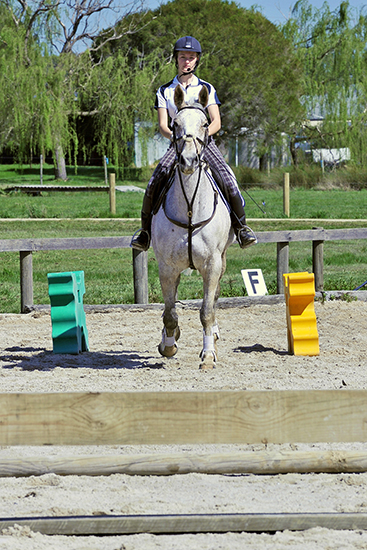
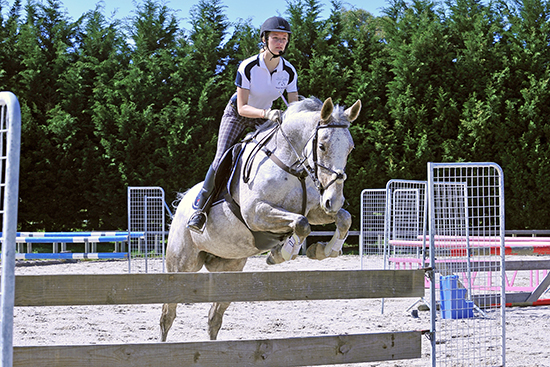 “When I ask you to move her off your right leg, what does she do? She sticks her head up and runs away. Slow things down, and think – what am I trying to correct? Break things down to their components, it is much easier for the horse to learn if you don’t try to do six things at once. Do one simple thing over and over, horses are creatures of habit, and it’s our job to give them good habits. Put your right leg on if she does not understand, walk leg yield, turn on the forehand, teach her, do not just try and muscle her, she is much stronger than you.”
“When I ask you to move her off your right leg, what does she do? She sticks her head up and runs away. Slow things down, and think – what am I trying to correct? Break things down to their components, it is much easier for the horse to learn if you don’t try to do six things at once. Do one simple thing over and over, horses are creatures of habit, and it’s our job to give them good habits. Put your right leg on if she does not understand, walk leg yield, turn on the forehand, teach her, do not just try and muscle her, she is much stronger than you.”
“Watching you, your distances to the poles are not brilliant; you are not dialing up the right canter. Do your flatwork at home over poles, do 100s of poles at home, so you are learning to dial up the right blend of canter to produce a good distance. You have good eye for a distance, you just get caught on a bad canter. ”
And in case you hadn’t noticed, Michelle is a hard taskmaster: “Sometimes at home, ride without stirrups, and sometime jump without stirrups, that will help you keep a better balance in the saddle.”
“And I’ve got some more homework, look up travers and renvers. That’s what we are aiming at, that will give you a goal, and once you understand them, then you’ll understand what we have to do to get the flying changes… but that is another time, another lesson.”
Jess tells me she has been riding Charity for four years: “We’ve come a long way, but we still have a long way to go. She was very green when we got her. She was jumping the tracks but not getting to the fences that well… now she is getting there.”
“Michelle has really been helping me improve her rideability. Straightness is the thing we are working on at the moment. Getting her to travel a lot better to the fences – she’s got a really good scopey jump, but we have to get her to the fence better.”
Jess is another young rider with big ambitions:
“Obviously I’d love to go to the Olympics, but that is a big stretch. With her, I just want to get her jumping the bigger tracks, getting there smoothly. Hopefully we’ll get to the bigger competitions, travel interstate, and then eventually, hopefully, go to Europe and work in stables over there, and see how it works there.”
Who is your role model?
“I don’t really know, probably Edwina Alexander, but there are so many top riders out there that look so good…”
I remark to Michelle that she is very lucky with the group of students she has…
“I am lucky with my students, very lucky. I have quite a lot of students, just like that, and they all want to learn. It has changed in the last couple of years, I don’t know if they are watching more from overseas, or because now they are buying purpose-bred horses and they are learning that they have to give them a different ride and learn how to educate them.”
“I think there are plusses in the situation in that we are starting to develop a lot of young riders that are educated riders and if they stay in the industry, we are going to have future coaches.”
Jess’ mare might have a nice jump, but she is not conformed to be the easiest horse to put together…
“Exactly, that’s why if Jess is going to make her into a horse, she needs to have the skills to produce this horse to be straighter, and more adjustable in the canter, but as you can see, she is a lovely student and really open and hungry to learn. First of all, we had to get Jess riding in a good position because she’d never ridden without stirrups much, and she always rode with very short stirrups, draw reins, tight low hands, and that system doesn’t work on these horses – really it doesn’t work on any horse. The hot buzzy horses off the track did allow riders to have reasonable success, just working off their revs, not education. These Warmblood horses won’t do that, they just leave their hocks further and further out the back, they can turn into semi-trailers. Riders are starting to realize that they can’t manufacture a round just on the rider’s muscles, they can’t get them around a course without learning to ride them on the flat, which is beautiful.”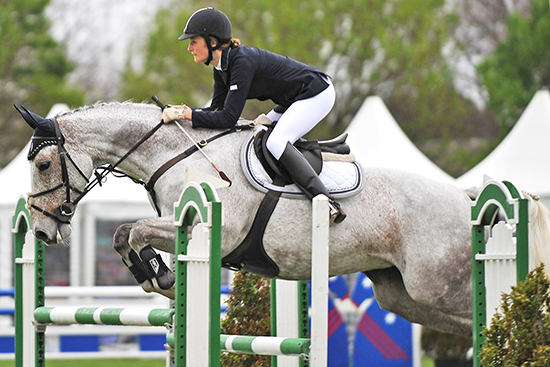
How long have you been working with Jess?
“I knew Jess when she was a little tacker, then I was travelling backwards and forwards overseas, so I didn’t see her for a number of years. We’ve probably had ten lessons now, and she has come a long way. When we started the mare’s head would be going to the right, and the body to the left – there has been a massive change. But you have to be careful; these riders are competing, so there has to be a balance. You can’t say, OK back to the drawing board and you must not jump for twelve months, that’s ridiculous. You have to try and find a balance – keep the fences coming up and competing, but trying to change habits.”
“I had another new client the other day, and she had no idea that the horse was on two tracks the whole time, and she was wondering why she couldn’t get round a right hand turn. She didn’t have a clue and yet she’s been jumping around for five years! You have to come back a little to the drawing board and get basic straightness, just give them the concept that all four legs travel in a line in the direction you want to go – that’s a good starting point.”
“But the encouraging thing is that it is starting, that the riders are realizing that sure, these new purpose-bred horses are the horses of the future, but at the same time, they have to learn how to ride and train them. It’s an exciting future.”
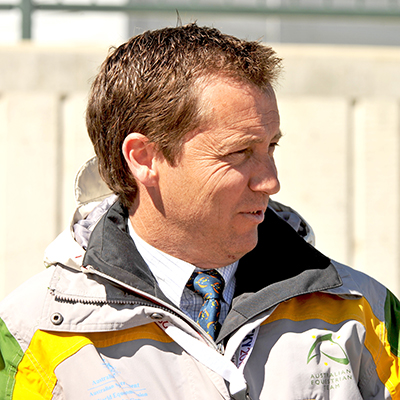 Stephen Lamb – Managing the Future
Stephen Lamb – Managing the Future
As chef d’equipe of the Australian showjumping team, and recently appointed as Jumping High Performance Manager, Stephen Lamb is intimately involved in shaping the future of our young riders…
You have talked about Australia, if not being the university, at least being a good secondary school when it comes to producing jumping riders, what pathways are there for young riders to be good students in this school?
“That is an area where the education is really falling down when they come out of young rider. In that 21 to 30 age bracket, we have a range of really good kids who have done a lot of miles but then they get out into open competition and a lot of them are disappearing. With what we are doing now with the Talent ID days, and having the Future Squad where we are bringing on the 5, 6, 7 year old horses, a part of that is trying to keep some of those younger riders in that group in the loop. They usually have a nice young horse, so you can keep them in the system and keep monitoring their training.”
“You take a rider like Jamie Kermond. Here was a kid who went to the WEG in 2006 – sure now he is back at the top – but there was a period after 2006, for a couple of years where he didn’t have a Grand Prix horse.”
And he spends most of his time with a leather apron and a farrier’s hammer in his hand…
“That’s right, and that’s fine, we’ve all got to work for a living, but it’s a shame that a talented young rider like that, you lose contact with them. The country is littered with talent like that, certainly not all of them get to go to a WEG as young as Kermo did, but there’s plenty of young riders out there, like Ben Blay, the boy who is working with Vicki Roycroft now, we need to keep them progressing and on a forward path. We’ve got to recognize the rider talent that we’ve got, and then try to produce the horse talent, and hopefully we are on the way to international competitiveness.”
Isn’t the problem with finding the horse talent, the fact that the most talented riders are not necessarily the ones with the richest parents…
“Sure, and that is a global problem. Jessica Springsteen can just go out and buy Peter Charles’ gold medal horse, we should all have Dads who make as much as Bruce… I do think though that with the number of well-bred horses in the country, there will always be an opportunity for those good riders to source a sound proposition, and as whilst they may not be at Grand Prix, if they have a nice young horse, 5, 6, or 7 years old, then they are in the system through our young horse program.”
It’s a nice idea but in the past some of the educational assistance offered around the traps has been of questionable value – there have been some pretty awful official EFA coaches and the new EA federal coaching panel certainly does not inspire any confidence if we are looking for a group with a proven record of producing elite competitors… who are going to be the people spreading this information to the riders?
“That EA education panel is a different group from the people involved in our High Performance program – and our program is not necessarily about going out and coaching, it is more about monitoring the ongoing training. Whether it is Gilbert Böckmann, when he is in Australia, or Rod Brown. Gilly comes out three or four times a year, and even if Rod could do three or four clinics in each state each year, the number of contact hours with the rider is something like 10 or 12 hours. That does not make a coach / rider relationship. What the rôle is more about is monitoring what that rider is actually doing with that horse, working with the trainers of those riders. As a High Performance panel we can’t be turning up every other day to work with the rider – it is more about helping those personal trainers who do work with the riders. If Rod is doing a clinic, then we want the rider’s trainer to be part of it, otherwise it is not an effective system – there are just not enough hours that we can get in front of people.”
Are we going to make more use of people like Greg Best and George Morris – I understand this year, the funding support for the George Morris schools has been withdrawn, and now there won’t be one at SIEC…
“That is to do with NSWIS and their equestrian program… from the Jumping High Performance program there will still be an involvement with George’s clinics, in the form of a subsidy for the listed riders. We can’t control the NSWIS… but basically our coaching program will be focused on Gilbert and Rod. What we do need to do is make better use of them, and that there is a progression and we are helping the ones who want to be helped.”
Looking around the Australian jumping scene at the moment, do you see young riders who have the potential to force their way into a team, not necessarily for Caen, but perhaps for Rio?
“Absolutely. At the very top of the young riders there is a very competitive group. Obviously Tom McDermott gets a lot of attention, Olivia Hamood has spent time in Europe, she is going back to Europe, she is asserting herself as one of the top young riders in the country, Nicole Bruggemann, Jack Maunder… I think our young rider ranks are stronger than they have even been, particularly there, with kids that have grown up with the sport…”
Purpose bred…
“Purpose bred for the sport, and our job is to look at what we can do for those riders, and for my money one of the biggest skills they are going to need is the ability to source and manage owners. I think that is something we have to look at. The ability to have an owner, manage that owner and keep that owner, that is a skill set we should be helping these kids with…”

